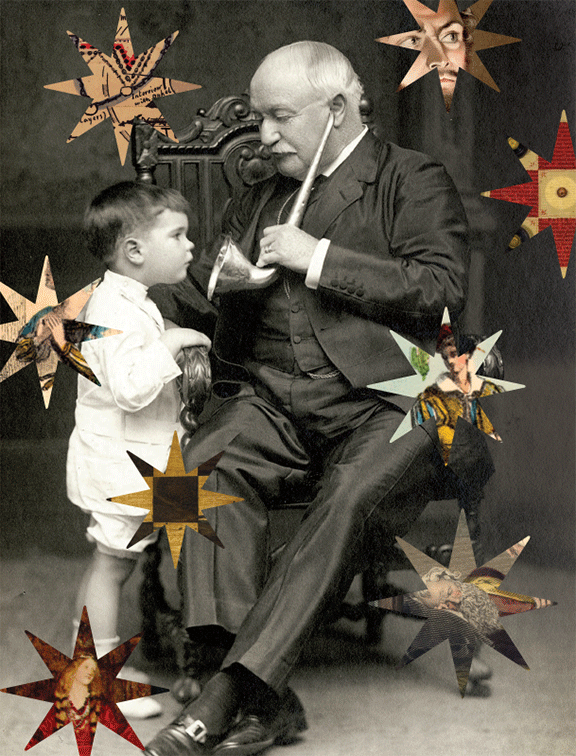
Horace Howard Furness was a hopeful ghost-hunter, a Penn leader with a gift for stimulating donors’ “pocketbook nerve”—and the founder of modern Shakespeare scholarship.
BY DENNIS DRABELLE
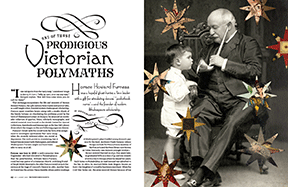
“I can call spirits from the vasty deep,” Glendower brags in Henry IV, Part 1. “Why, so can I, or so can any man,” Hotspur replies. “But will they come when you do call for them?”
That exchange encapsulates the life and interests of Horace Howard Furness, the 19th-century Penn trustee and provost who, as a self-taught editor, founded modern Shakespeare scholarship. Furness spent countless hours—along with a sizable chunk of the family fortune—on elucidating the problems posed by the texts of Shakespeare’s plays; in doing so, he amassed an invaluable collection of quartos, folios, scholarly monographs, and related material, now housed in the Kislak Center for Special Collections, Rare Books and Manuscripts in the Van Pelt Library (from which the images on this and following pages are drawn).
Furness’s brush with the occult took the form of an assignment to investigate spiritualism that came along when the recently widowed editor was mired in depression. The work proved so stimulating that it helped him reconnect with Shakespeare, and without Shakespeare Furness might not have been able to carry on at all.
Furness was born in 1833 to well-connected New Englanders who had relocated to Philadelphia so that the paterfamilias, William Henry Furness, could become pastor of a Unitarian church. A lifelong friend of Ralph Waldo Emerson’s, the elder Furness would preach the sermon at the Sage of Concord’s funeral in 1882. Another family friend was the actress Fanny Kemble, whose public readings of Shakespeare’s plays kindled young Horace’s passion for the Bard. (Architect Frank Furness—whose designs include the Pennsylvania Academy of the Fine Arts and the Penn library now known as Fisher Fine Arts—was Horace’s younger brother.)
Horace entered Harvard in 1850; four years later, he graduated fifth in a class of 91 and was rewarded with a trip to Europe, where he stayed two years. Back home in Philadelphia, he read law and was admitted to the bar. In 1860, he married Helen Kate Rogers—known as Kate—the daughter of a wealthy hardware merchant. When the Civil War broke out, the army rejected Horace because of his poor hearing, an aftereffect of scarlet fever, which he’d come down with after returning from Europe. Instead he became an inspector of hospitals for the US Sanitary Commission, which aided sick and wounded Union soldiers.
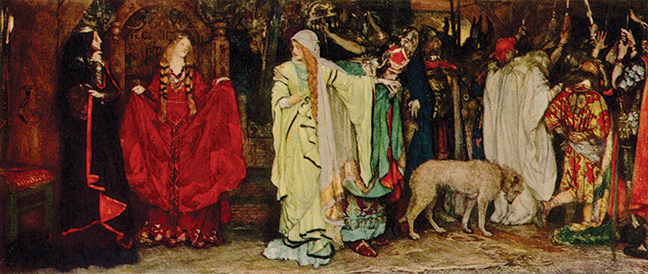
By then Furness was a member of Philadelphia’s Shakspere Society. (Re the name: Penn English professors Margreta de Grazia and Peter Stallybrass, in a 1993 article in Shakespeare Quarterly, note that no two of the Bard’s six surviving “supposed autographs” are spelled the same way—but none of them include an e between the surname’s two syllables. The e may well have been inserted by printers to avoid setting a k before an s—the long s of the period, that is, which looks like an f—because the two letters would crowd each other and were apt to break during the printing process. “To avoid breakage (and the ensuing fine),” de Grazia and Stallybrass explain, “a compositor would set a neutral typebody between k and long s”—sometimes a hyphen, sometimes an e. Thus, today’s received spelling “is not that of the author’s hand but that of the printer’s press and reflects not a personal investment in the question of identity but rather an economic use in the preservation of typeface.”)
Furness and his fellows in the Society—all lawyers—pored over the plays almost as if they were statutes to be construed.And there was plenty of construing to be done: Shakespeare’s plays are replete with puzzling words and enigmatic phrases. Samuel Johnson, himself an editor of Shakespeare, elaborated on the difficulties of arriving at accurate versions of what were written, after all, not as texts to be venerated but as scripts to be played for maximum dramatic effect:
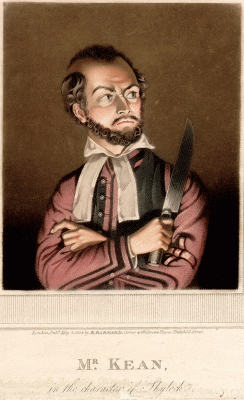
“Copied for the actors, and multiplied by transcript after transcript, vitiated by the blunders of the penman, or changed by the affectation of the player; perhaps enlarged to introduce a jest, or mutilated to shorten the representation; and printed at last without the concurrence of the author, without the consent of the proprietor, from compilations made by chance or by stealth out of the separate parts written for the theatre; and thus thrust into the world surreptitiously and hastily, [the plays] suffered another depravation from the ignorance and negligence of the printers. … It is not easy for invention to bring together so many causes concurring to vitiate a text.”
A famous repair of a line mangled in one or more of the ways cited by Dr. Johnson can be found in Henry V, when the Hostess narrates the offstage death of Sir John Falstaff. Her touching account included this peculiar detail: “and a Table of greene fields.” One day while ruminating on that passage, the English poet and editor Lewis Theobald (1688-1744) had a eureka moment: “a Table” was a misprint for “ ‘a babbled”—which is to say, “he babbled.” Falstaff, then, wasn’t enumerating his furniture but imagining the pastoral heaven to which he hoped to be carried off. Most subsequent editors have adopted Theobald’s hunch, which is considered a classic instance of editorial mind-reading.
Theobald, incidentally, appears as the anti-hero of the original version of The Dunciad, his contemporary Alexander Pope’s mock-epic about the sorry state of 18th-century British letters. Scalded by Theobald’s attacks on Pope’s own Shakespeare edition, Pope described the Bard as being left “sore” by his encounter with Theobald. But according to Pope’s biographer Peter Quennell, “There is no doubt that [Theobald] was a far more competent editor than Pope, and had a deeper understanding of Shakespeare’s literary background.” When Pope revised The Dunciad years later, he gave it a new dunce-in-chief, the poet Colley Cibber.
Furness and his fellow lawyers may not have risen to Theobaldian heights, but they found Shakespearean problem-solving so enthralling that they began collaborating on variorums. As glossed by Ron Rosenbaum in his book The Shakespeare Wars, the term variorum comes from cum notis variorum, Latin for “with the notes of various persons.” A variorum of a Shakespeare play is a master edition that discusses discrepant or obscure words and phrases found in the quartos, folios, and later editions, with summaries of previous editors’ opinions. A typical variorum page might display half-a-dozen lines of Shakespeare, beneath which crouches a subterranean mass of small print: footnote after footnote offering alternate readings and the supporting arguments.
A venerable tradition of variorums stretched as far back as 1803, and the most recent set was getting on to 50 years of age. But why would the Philadelphia lawyers undertake variorums rather than straightforward new editions of the plays? The answer has to do with the zeitgeist. In an essay on the Furness legacy in a commemorative volume called The Penn Library Collections at 250, longtime rare-books curator Daniel Traister argues that variorum-making reflected the cataloguing, classifying, toting-up mentality of 19th-century scholars, as embodied in such “industrial” British projects as the Oxford English Dictionary, the Dictionary of National Biography, and the ninth edition of the Encyclopaedia Britannica. The Philadelphians’ variorum initiative, Traister writes, “like those other great monuments of Victorian scholarship, [was] rooted in a commitment to the good that can emerge only from a cumulative, rational methodology.”
Furness found his new hobby far more rewarding than practicing law, which in any case was tough sledding for someone so hard of hearing that he had to use an ear trumpet. Also, he was the right man for the job: patient, dogged, learned, and proficient enough in French and German to report the views of editors writing in those tongues. Rosenbaum sums up Furness as “one of those prodigiously erudite and energetic Victorian polymaths,” and Furness’s fellow members of the Shakspere Society must have thought so, too. They deferred to him, and soon he was the variorums’ only begetter. His wife toiled in the adjacent field of the concordance: a list, with commentary, of all the words found in a given author’s works. Her concordance covered the Bard’s non-dramatic poems.
The Furnesses’ lives changed markedly when Kate’s father died, leaving her a $750,000 trust fund. With Kate’s encouragement, Horace gave up the law, freely indulged his collecting impulse, and subsidized publication of the variorums he continued to labor over.
On second thought, “labor over” may give the wrong idea. “Exult in” sounds more like it. In Furness we have a splendid example of a man who gets rich and devotes his wealth and leisure to a fulfilling and useful purpose. His variorums and related correspondence ring with the pleasure he took in attacking textual problems. When a friend suggested a felicitous reading of a murky line in Antony and Cleopatra, Furness replied, “If Shakespeare didn’t mean that he ought to be ashamed of himself.” When Furness tackled The Winter’s Tale, he took pains to ascertain what Antigonus means by threatening to “Land-damne” an enemy (II, i,143). After sorting through a dozen or so possibilities, none of them wholly satisfactory, Furness ended on this wry note: “We can all grasp the meaning of the last half of ‘Land-damne,’ and I would add, that to understand half of Shakespeare’s meaning in a difficult passage is something to be not a little proud of.”
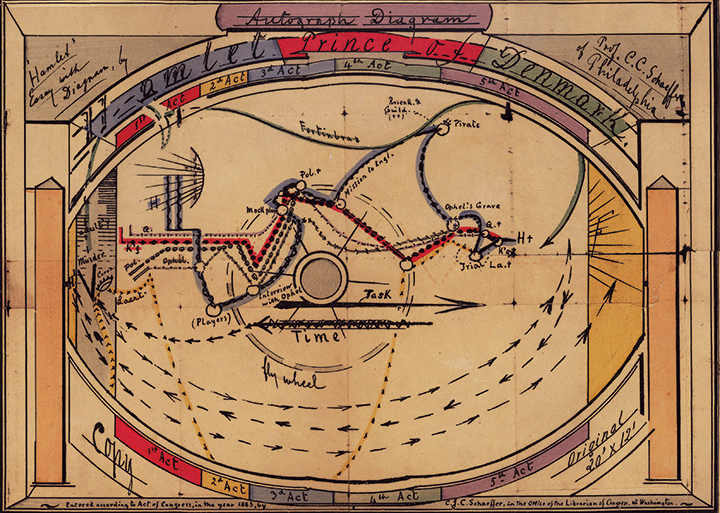
Each variorum was a formidable project, but Furness hit his stride with the great tragedies. Macbeth appeared in 1873, Hamlet in 1877, and King Lear in 1880, the same year the editor became a Penn trustee. Othello was next in line, but in 1883 that project slammed to a halt. Kate Furness died, leaving her husband desolate. “My life is done,” he wrote to a friend in 1884. “I cannot get up any interest in anything under the sun.” Turning down an invitation to lecture on Shakespeare, he complained of “being too unutterably weary with everything to stick to one purpose for longer than a half hour.”
Other than spending time with his children (there were three sons and a daughter), only one field of endeavor could even begin to lift the widower’s depression: his duties as a Penn trustee. He poured his energies into collegiate busywork, such as inspecting prospective rooming houses for students. Over one three-day period, he visited and took notes on 63 of what he called “these dreadful places of abode.”
What really saved him, though, was the Seybert Commission, the brainchild of Henry Seybert, a Philadelphia millionaire who yearned to see spiritualism vindicated by learned men operating under Penn’s aegis and left a bequest to the University to do just that when he died in 1881 [“Feet and Faith,” Mar|Apr 2006]. A few years later in 1884, Furness and nine other commissioners began auditioning mediums and evaluating their claims to be in touch with the souls of the dead.
Furness was named chairman of the commission—an interesting choice, in that he was the only one of the 10 personally invested in an outcome favorable to spiritualism. For if it lived up to its billing, he might obtain the immense comfort of hearing from the shade of his beloved wife. “I entered in the investigation almost a convert,” he wrote to a friend, “and at this hour I would give almost all I possess to be one.”
Three years later the commission concluded its work with nary a peep out of Kate or any other spirit. The mediums answering the call had all flopped, and the commission’s dismissive report would have sorely disappointed Seybert (had he not been dead already—and also neglected to write or call from the afterworld). Along the way, however, Horace had just about got his old self back. He found the commission’s work stimulating and at times comical, as when he asked six different mediums whose skull he kept in his study, and got six different answers. In the words of Furness’s biographer, James M. Gibson, “Aside from exposing spiritualism in all of its departments as a fraud, the Seybert Commission did what Shakespeare alone could not do; it recalled Furness from his mourning, from those agonized cries to Kate in the darkness of his grief, and restored him to the land of the living, of laughter, and of literature.”
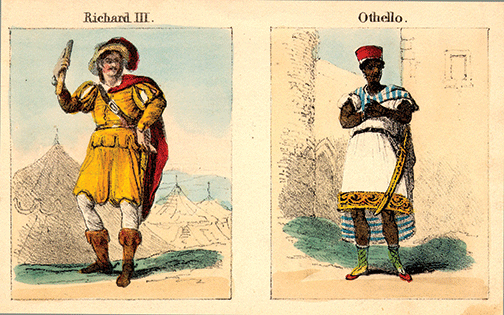
The revitalized Furness appears in a vignette that comes to us by way of the Shakespeare collector Henry Folger—he of the Folger Shakespeare Library in Washington—who met Furness in the late 1880s. According to Folger biographer Stephen H. Grant, Folger and his wife arrived for a visit to Lindenshade, the Furness estate in Wallingford, Pennsylvania, and were greeted on the lawn by the owner himself, who “burst out the door to blast a welcome on his trumpet.”
But the most telling sign of Furness’s recovery was his renewed interest in Shakespeare. He picked up the Othello variorum, finished it, and published it in 1886. When the Seybert Commission’s report came out a year later, Furness was already immersed in The Merchant of Venice. Over the next quarter-century, he completed 10 more variorums and was at work on an 11th when he died in 1912. Taken as a whole, according to Michael Witmore, current director of the Folger Library, Furness’s 18 variorums constitute a “landmark in scholarship.” This view is seconded by René Weis, the University of London professor who edited the recent Arden Shakespeare edition of Romeo and Juliet: Furness’s variorums, Weis writes, “marked the beginning of scholarly editing of Shakespeare.”
In addition to chipping away at textual obscurity and adjudicating whether mediums can call spirits from the vasty deep, Furness put in a stint as Penn’s provost, a job whose most important requirement, he quipped, was the knack for stimulating a potential donor’s “pocketbook nerve.” When not fund-raising for the University, he took on such mammoth tasks as modernizing its hospital and assembling its scattered book holdings into a unified research library (housed in brother Frank’s iconic building). His public readings of Shakespeare’s plays were well attended and much-praised. Although Furness did not remarry, he didn’t let his deafness stop him from socializing: his friends included Oliver Wendell Holmes, William Dean Howells, Mark Twain, and Walt Whitman. In short, the phase of Furness’s life that followed his work with the Seybert Commission may have been richer and fuller than the one that came before.
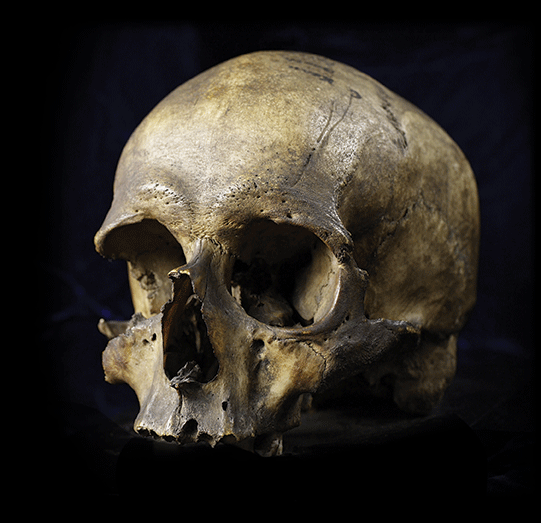
Unlike, say, the Pierpont Morgan Library in New York, which originated as a showcase for its owner’s wealth and taste, Furness’s library has always been meant to be used. Along with a $100,000 endowment, Furness’s collection was left to Penn in 1931 by the will of Horace Junior and his wife, Louise. Today the collection encompasses some 12,000 titles. Newer books are shelved in the Horace Howard Furness Memorial, a reading room on the sixth floor of Van Pelt. Nearby is the Special Collections Center, which affords access—by request and under supervision—to the heart of the Furness collection, kept under lock and key one floor below.
Thanks to David McKnight, director of Penn’s Rare Book and Manuscript Library, I was able to peruse several quartos (small editions devoted to individual plays) and a folio (a larger-sized compendium of multiple plays). Like most English majors, I’d glanced at reproductions of quarto and folio pages in the texts I read in school. But handling the originals—with their sturdy paper, made from shredded rags; deep impressions made by the type; and archaic spellings and punctuation—gives a sense of the fun Furness must have had in tracking such rarities down.
He also acquired non-literary materials pertaining to Shakespeare, including images of actors, playbills, the human skull that served as poor Yorick’s in 19th-century stagings of Hamlet at Philadelphia’s Walnut Street Theatre, and even a pair of gloves said to have belonged to the playwright.
(They almost certainly did not: among the Furness papers is a folder labeled “Glove Correspondence,” which contains the droll reply to a 1916 letter from Horace Junior to the curator of the Shakespeare Memorial Theatre in Stratford on Avon. In his letter, Horace Junior had described the gloves in his father’s collection. “It will interest you to know,” the curator wrote back, “that we already have a reputed pair of Shakespeare gloves very similar to the ones you possess.”)
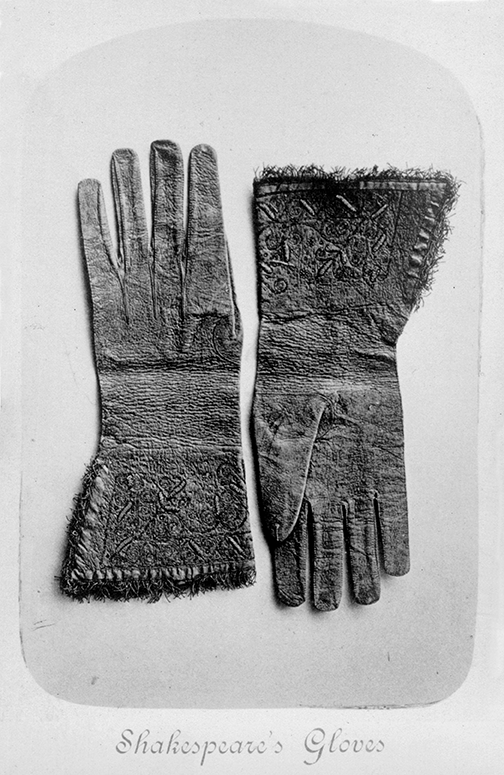
This portion of the collection reflects an opinion voiced by Furness in the preface to his Othello variorum: “in the interpretation of Shakespeare’s plays, our first appeal, and perhaps our last, should be made to the dramatic intent … with which eminent Actors are especially endowed.”
Othello was one of two Furness variorums I spent time with back on the sixth floor, the other being A Midsummer Night’s Dream. Each stout volume was published between red covers by the Philadelphia firm of J.B. Lippincott, but there is a striking difference between them. The Othello preface quoted from above is only eight pages long, its brevity probably a function of Horace’s mourning of Kate. Nine years later, when the Midsummer variorum came out, the editor was in fine fettle again: its preface runs to 34 pages.
A Shakespeare play can be daunting enough in its own right; the intimidation grows when you dwell on all the squabbling over precisely what the poet meant to say. It may be a comfort, then, to close with this comment from an undated essay by Furness published in the magazine Poet-Lore:
“Far too great stress has, I think, been laid upon the difficulties and obscurities of Shakespeare’s text. It is mainly the scholars who emphasize these blemishes; to us simple folk the meaning in many a disputed passage is as plain as the way to [our] parish church, and when we listen to the play on the stage, and the plays were written to be thus listened to, there is a not a difficulty from the first scene to the last.”
Dennis Drabelle is a contributing editor of The Washington Post Book World.

